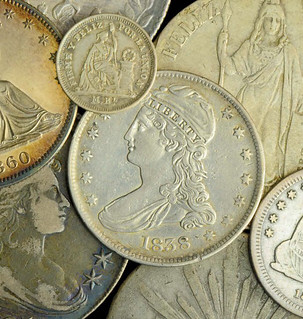
PREV ARTICLE
NEXT ARTICLE
FULL ISSUE
PREV FULL ISSUE
WHERE COINS DISAPPEARED TO IN THE CIVIL WARE-Sylum contributor David Ginsburg published a nice article in the October
2014 issue of The Numismatist, the official publication of the American Numismatic
Association. "Into the Melting Pot: Silver Coins During the Fractional Currency Era"
examines just what happened to all the coins that disappeared from circulation during and after the
U.S. civil war. With permission, here's an excerpt. If you're an ANA member, be sure to
read the complete article. -Editor
Silver coinage, which had been slowly disappearing from circulation, was by then completely absent from the channels of commerce. Everyday retail transactions were completed with a combination of cents and fractional scrip until federal fractional currency was introduced in Fall 1862. [To learn more] I set out to study 19th-century periodicals, electronic versions of which are now freely available on a number of websites. My efforts were rewarded by James Parton’s profile of the Gorham Manufacturing Company in the September 1868 issue of Harper’s New Monthly Magazine. In addition to a history of the demand for silver spoons in New England and an explanation of how sterling (.925 fine) became the standard for American silverware, the text offered much to satisfy a numismatic researcher. The numismatically relevant portions of the article are excerpted here. …Generally, however, it is to Wall Street or its vicinity that the makers of silver-ware resort for their daily supply of the precious metals. In these times, when the price of gold and silver changes every minute or two, and sometimes more than once in a minute, no one buys a large quantity in advance. There are often in course of treatment, in the various apartments of the Gorham factory, as much as three tons of silver; but it is only necessary to start one or two thousand ounces every morning on their progress through the establishment in order to keep every department in full activity. The time has been when silversmiths could not buy in all New York five hundred dollars’ worth of silver, and they had to run about Chatham Street hunting up little lots of dimes and half-dimes that used to be displayed in the windows of lottery shops. These bullion and coin dépôts in Wall Street are interesting to the unaccustomed visitor. There is something respectable, if not impressive, about a long row of large, smooth kegs of Mexican or Peruvian dollars rough from the mint. …Most interesting of all is it to see great heaps of the small silver coin of the country, long lost to sight, to memory dear. I ventured to ask the great King of the Bullion Dealers—one of those mighty men who buy half a million of gold with a wink, and sell it again with a nod—I say I took courage to ask this potentate what had become of all the small silver coin which we used to have in circulation, but which children six years of age have never seen. “Where,” said I, “are the dimes and half-dimes and quarters at this moment? The silver-smiths melt only dollars and half dollars. Where, then, have the small coins gone?” He replied that a large quantity of them had found their way to Canada; more still to the West Indies and South America; but that there is still a large amount of it in this country, performing the office of a savings-bank to ignorant and timid people. A proof of this is that parcels of it frequently come into “the street” from distant points. I saw, myself, that day ten thousand dollars’ worth in one heap, which had just arrived from the country, and was about to be shipped to Havana, where it would then be used to advantage. This article illustrates the great advantage of reading contemporary sources: the time period is brought to life in a way that no secondary source can match, and it includes details that might have been overlooked or not thought relevant by subsequent researchers. In just a few pages, I learned not only where many American silver coins went during the Civil War, but also gained some insight about how many of them might have disappeared into silversmiths’ melting pots across the country; how much of a problem contemporary counterfeit coins presented; and how they were detected and destroyed. Wayne Homren, Editor The Numismatic Bibliomania Society is a non-profit organization promoting numismatic literature. See our web site at coinbooks.org. To submit items for publication in The E-Sylum, write to the Editor at this address: whomren@gmail.com To subscribe go to: https://my.binhost.com/lists/listinfo/esylum All Rights Reserved. NBS Home Page Contact the NBS webmaster 
|
